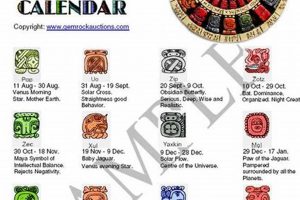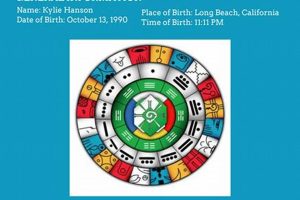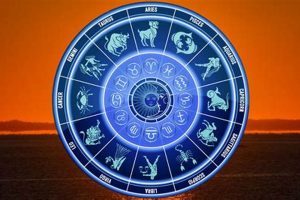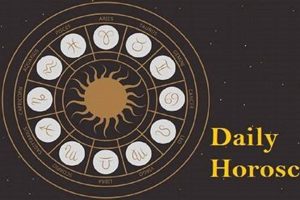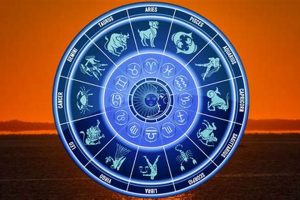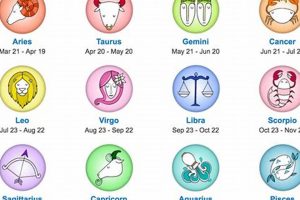Volumes exploring this ancient Mesoamerican system offer insights into the Mayan calendar, its intricate cycles, and their connection to personality traits, destiny, and historical events. These resources often contain detailed explanations of the 260-day Tzolk’in calendar and the 365-day Haab’ calendar, along with interpretations of the combined Calendar Round. A typical example might include descriptions of each day sign and its associated meaning, as well as information on how these interact with the thirteen numbered positions within the Tzolk’in.
Studying these systems provides a fascinating glimpse into Mayan cosmology and worldview. Understanding the cyclical nature of time, as perceived by the Maya, offers a unique perspective on the interconnectedness of past, present, and future. This knowledge can contribute to a deeper understanding of Mayan culture and history, as well as offer potential avenues for personal reflection and growth. The Mayan calendar system, distinct from the Gregorian calendar, continues to hold significance for many individuals and communities today.
This exploration delves further into the intricacies of the Mayan calendar, its significance within Mayan culture, and its contemporary relevance. Subsequent sections will examine specific calendar components, interpretative methods, and the enduring legacy of this complex astrological system.
Tips for Understanding Mayan Astrology
These tips offer guidance for navigating resources on this complex subject and integrating the insights they provide.
Tip 1: Begin with the basics of the Tzolk’in and Haab’ calendars. A solid foundation in these two distinct calendar systems is crucial. Focus on understanding their individual structures and how they interact to form the Calendar Round.
Tip 2: Explore the meanings of the day signs and numbers. Each day within the Tzolk’in possesses a unique combination of a day sign (such as Imix or Ik) and a number (from 1 to 13). Understanding their individual and combined meanings is essential for interpretation.
Tip 3: Consider the context of the Long Count. While not strictly astrology, the Long Count provides a broader historical framework for understanding specific dates and their significance within Mayan history.
Tip 4: Consult reputable sources and authors. The field of Mayan studies requires careful discernment. Seek out authors who demonstrate scholarly rigor and respect for Mayan culture.
Tip 5: Be patient and persistent. Mastering this system takes time and dedication. Approach the learning process with curiosity and a willingness to explore its complexities.
Tip 6: Apply the knowledge to personal reflection. Consider how the insights gained from this system can provide a unique lens for understanding one’s own personality, strengths, and challenges.
Tip 7: Avoid generalizations and oversimplifications. Respect the depth and complexity of the system and avoid applying interpretations rigidly or without nuanced understanding.
By following these tips, individuals can develop a more comprehensive and meaningful understanding of Mayan astrology and its enduring relevance.
This exploration concludes with a summary of key concepts and a discussion of future research directions in this fascinating field.
1. Calendar Systems
Calendar systems form the foundational structure of Mayan astrology. A thorough understanding of these systems is essential for interpreting the complexities within any Mayan astrology book. The interplay between the 260-day Tzolk’in and the 365-day Haab’ calendars, creating the 52-year Calendar Round, provides the framework for astrological calculations and interpretations. A Mayan astrology book utilizes these systems to determine specific energy influences based on birth dates and other significant dates. For example, a person born on a day marked by the Tzolk’in day sign Imix and the Haab’ day position 8 Kumk’u will find detailed explanations of these combined energies within such a book. The calendar systems, therefore, act as a map through which practitioners navigate the intricacies of Mayan astrology.
The Long Count calendar, while not strictly astrological, provides an extended historical context. This chronological system anchors specific events and cycles within Mayan history, offering additional depth to interpretations presented in a Mayan astrology book. Furthermore, the concept of time as cyclical, embedded within these calendar systems, emphasizes the interconnectedness of past, present, and future. This perspective influences how events and individual destinies are viewed within Mayan astrological interpretations. The interplay between the Tzolk’in, Haab’, and Long Count allows for precise identification of significant periods within a lifetime, offering insights into potential challenges and opportunities as detailed in Mayan astrology books.
In summary, calendar systems serve as the essential key to unlocking the wisdom contained within a Mayan astrology book. They provide the structure for understanding cyclical time, interpreting the meaning of specific dates, and integrating these insights into a broader understanding of Mayan cosmology and worldview. Successfully navigating the intricacies of these calendar systems represents a critical first step toward comprehending the depth and complexity of Mayan astrology. Further research might explore the mathematical principles underpinning these systems and their connection to astronomical observations.
2. Day Signs
Day signs represent fundamental building blocks within Mayan astrology, functioning as core components for understanding personality traits, predicting auspicious days, and interpreting cyclical patterns. A Mayan astrology book dedicates significant attention to these signs, providing detailed interpretations and exploring their significance within the broader Mayan cosmological framework. Understanding these signs is crucial for anyone seeking to utilize these resources effectively.
- Symbolism and Meaning
Each of the 20 day signs carries unique symbolic meaning, representing distinct energies and characteristics. Imix, for example, symbolizes primordial origins and creation, while Ik represents wind and breath. A Mayan astrology book details these symbolic associations, often connecting them to natural phenomena, deities, or specific aspects of Mayan life. These meanings provide a basis for interpreting the influence of each day sign on an individual’s character and destiny.
- Tzolk’in Sequence
The day signs appear in a fixed sequence within the 260-day Tzolk’in calendar. This cyclical progression creates unique combinations with the 13 numbers of the Tzolk’in, influencing the energy of each day. Mayan astrology books often include charts or tables illustrating this sequence, allowing readers to determine their birth day sign and its corresponding number. This information provides personalized insights into individual characteristics and potential life paths.
- Combinations and Interactions
The interaction between day signs further enriches their interpretations within Mayan astrology. Certain combinations are considered more auspicious or challenging than others, influencing the overall energy of specific periods. A Mayan astrology book explains these interactions, often providing guidance on navigating potential difficulties or maximizing favorable periods. For example, the combination of Imix and Ik might be interpreted differently than the combination of Ik and Akbal, highlighting the dynamic nature of day sign interactions.
- Divinatory Practices
Day signs play a central role in traditional Mayan divination practices. Mayan astrology books may explore how these signs were used historically to guide decisions related to agriculture, ceremonies, and other aspects of life. This historical context provides valuable insights into the practical application of day sign knowledge and its integration within Mayan culture. Understanding these practices offers a deeper appreciation for the enduring significance of day signs in contemporary Mayan communities.
By exploring the symbolism, sequence, interactions, and divinatory uses of day signs, a Mayan astrology book provides a comprehensive framework for understanding their influence on individual destinies and broader cyclical patterns. This intricate system offers valuable insights into Mayan cosmology and its continued relevance in contemporary interpretations of time and destiny. Further research might explore regional variations in day sign interpretations and their connection to specific Mayan lineages or communities.
3. Number Glyphs
Number glyphs represent a crucial element within Mayan astrology, serving as numerical coefficients that modify and refine the energies of the day signs. A Mayan astrology book relies heavily on these glyphs to provide a complete interpretation of the calendar and its influence on individual destinies. Understanding the numerical values and associated meanings of these glyphs is essential for deciphering the complexities of Mayan astrological calculations.
- Numerical Values
Each number glyph, from 0 to 19, possesses a specific numerical value. These values interact with the day signs to create unique energetic combinations. For instance, the number glyph representing 1 might amplify the inherent energy of a day sign, while the glyph for 7 might introduce a more introspective or analytical quality. A Mayan astrology book explains these numerical associations, providing a framework for understanding how they modify the day sign energies.
- Symbolic Associations
Beyond their numerical values, number glyphs also carry symbolic meanings. These symbolic associations often relate to cosmological principles, natural phenomena, or specific deities within the Mayan pantheon. For example, the glyph for 0 might symbolize completion or wholeness, while the glyph for 13 might represent the levels of heaven. Mayan astrology books delve into these symbolic interpretations, adding layers of meaning to the numerical values.
- Tzolk’in Combinations
Within the Tzolk’in calendar, number glyphs combine with day signs in a fixed sequence. This combination creates a unique energetic signature for each day within the 260-day cycle. Mayan astrology books utilize this sequence to interpret the energies influencing specific dates, offering insights into personality traits, favorable or challenging periods, and potential life paths. Understanding these combinations is essential for applying Mayan astrological principles to personal circumstances.
- Long Count Correlations
While primarily associated with the Tzolk’in, number glyphs also play a role in the Long Count calendar. This chronological system uses a base-20 numbering system, incorporating glyphs to represent different time periods. Mayan astrology books may explore how these Long Count correlations provide historical context and broader cyclical patterns influencing individual destinies. This connection highlights the interconnectedness of Mayan calendar systems and their combined influence on astrological interpretations.
In summary, number glyphs contribute significantly to the depth and complexity of Mayan astrology. They provide a nuanced understanding of the energies at play by modifying day signs, offering symbolic interpretations, and interacting within different calendar systems. A Mayan astrology book serves as a guide to navigating these complexities, offering insights into individual destinies and the cyclical nature of time. Further exploration might involve examining the mathematical principles underlying the use of number glyphs within Mayan calendrical calculations and their relationship to astronomical observations.
4. Interpretations
Interpretations constitute the core purpose of a Mayan astrology book, translating the complex interplay of calendar systems, day signs, and number glyphs into meaningful insights. These interpretations provide a framework for understanding personality traits, forecasting potential life paths, and navigating the cyclical nature of time as perceived by the Maya. A Mayan astrology book serves as a guide to these interpretations, offering detailed explanations and practical applications of this ancient system.
- Personality Traits
A Mayan astrology book often connects specific day signs and number combinations to personality traits. For example, individuals born on a day associated with the day sign Kan might be described as possessing strong intellectual abilities and a natural inclination towards leadership. These interpretations offer individuals a framework for understanding their strengths, weaknesses, and potential challenges.
- Life Path and Destiny
Mayan astrology interpretations extend beyond personality traits to encompass broader life paths and destinies. A Mayan astrology book might suggest that certain combinations indicate a predisposition towards specific careers, relationships, or spiritual pursuits. These interpretations are not viewed as deterministic but rather as potential pathways influenced by energetic predispositions. Individuals are encouraged to utilize this knowledge for self-reflection and informed decision-making.
- Auspicious and Inauspicious Days
Mayan astrology books frequently provide guidance on identifying auspicious and inauspicious days for specific activities. This information historically informed agricultural practices, ceremonies, and other significant events. Contemporary interpretations may apply this knowledge to modern contexts, such as choosing favorable dates for business ventures or personal milestones. The cyclical nature of the calendar emphasizes the recurring patterns of favorable and challenging periods.
- Ritual and Ceremony
Mayan astrology books often connect specific interpretations to traditional rituals and ceremonies. These practices aim to harmonize individual energies with the broader cosmological forces represented by the calendar system. For example, a specific ceremony might be recommended for individuals born under a particular day sign to enhance their connection to their inherent strengths. Understanding these ritual connections provides a deeper appreciation for the practical application of Mayan astrology within its cultural context.
The interpretations presented in a Mayan astrology book offer a framework for understanding the intricate relationship between the Mayan calendar and individual destinies. These interpretations, while rooted in ancient traditions, continue to resonate with contemporary audiences seeking deeper self-awareness and connection to cyclical patterns of time. Further exploration might involve comparing different interpretative approaches within Mayan astrology and their relationship to specific lineages or regional variations.
5. Historical Context
Understanding the historical context is crucial for interpreting the information presented in a Mayan astrology book accurately. The Mayan calendar and astrological system developed over centuries, deeply intertwined with the cultural, religious, and political landscape of the Mayan civilization. Examining this historical context illuminates the evolution of these systems and provides valuable insights into their meaning and purpose.
- Classic Period Influence
The Classic Period (250-900 CE) represents a pivotal era in the development of Mayan astrology. Inscriptions and codices from this period, such as the Dresden Codex, reveal sophisticated astronomical observations and complex calendrical calculations. A Mayan astrology book often draws upon these historical sources to explain the origins and evolution of specific astrological concepts. Examining these historical roots provides a deeper understanding of the underlying principles and their significance within Mayan cosmology.
- Role of Scribes and Priests
Mayan scribes and priests played a central role in maintaining and interpreting the calendar system. Their specialized knowledge of hieroglyphic writing, mathematics, and astronomy enabled them to track celestial cycles, perform divinatory rituals, and record historical events. A Mayan astrology book frequently references the role of these specialists, highlighting their influence on the development and transmission of astrological knowledge. Understanding their social and religious functions adds another layer of interpretation to the information presented in such books.
- Post-Classic Period Adaptations
Following the Classic Period collapse, Mayan culture and traditions continued to evolve in the Post-Classic Period (900-1697 CE). Regional variations in astrological practices emerged, reflecting the diverse political and social landscapes of different Mayan city-states. A Mayan astrology book might explore these regional adaptations, highlighting the dynamic nature of astrological knowledge and its ongoing evolution in response to changing historical circumstances. Understanding these adaptations helps contextualize the diversity of interpretations found within Mayan astrology.
- Colonial and Modern Influences
The Spanish conquest and subsequent colonial period significantly impacted Mayan culture, including the practice of traditional astrology. While suppressed during colonial times, Mayan astrological knowledge persisted within certain communities, often blending with Christian beliefs and practices. A Mayan astrology book might address these colonial and modern influences, acknowledging the complexities and challenges of interpreting ancient traditions within contemporary contexts. This awareness allows for a more nuanced understanding of the evolution and adaptation of Mayan astrology throughout history.
By considering these historical facets, readers gain a deeper appreciation for the complexities of Mayan astrology. A Mayan astrology book, when viewed through this historical lens, offers more than just interpretations of individual destinies. It provides a window into the rich cultural tapestry of the Mayan civilization, its sophisticated understanding of time and cosmology, and the enduring legacy of its astrological system in the face of historical change. Further exploration might involve comparative studies of Mayan astrology with other Mesoamerican astrological traditions or an examination of the impact of modern archaeological discoveries on our understanding of these ancient systems.
6. Cosmological Beliefs
Cosmological beliefs constitute the foundational framework upon which Mayan astrology rests. A Mayan astrology book intricately connects astrological interpretations to a broader understanding of the Mayan cosmos, its cycles, and the interconnectedness of all beings within this cosmic order. Exploring these beliefs provides essential context for understanding the depth and significance of Mayan astrological interpretations.
- The Sacred Tree and the Three Realms
The concept of a sacred tree, often depicted as a ceiba tree, connecting the underworld (Xibalba), the earthly realm, and the heavens, permeates Mayan cosmology. A Mayan astrology book might explain how specific day signs or calendar cycles relate to these different realms, influencing the energies associated with particular periods. For example, certain periods might be considered more conducive to communicating with ancestors in the underworld, while others might favor activities related to the earthly realm. This interconnectedness between the realms highlights the cyclical nature of life, death, and rebirth within Mayan cosmology.
- The Hero Twins and the Creation Myth
The Mayan creation myth, featuring the Hero Twins Hunahpu and Xbalanque, plays a significant role in understanding the struggle between light and darkness, order and chaos. A Mayan astrology book might connect specific day signs to these mythical figures or relate calendar cycles to events within the creation narrative. For example, the day sign associated with one of the twins might be interpreted as carrying qualities of courage and resilience. These connections enrich astrological interpretations by linking them to fundamental narratives within Mayan cosmology.
- The Significance of Maize and the Cycle of Life
Maize held central importance within Mayan culture, representing sustenance, life, and the cyclical renewal of nature. A Mayan astrology book might explore the connection between agricultural cycles and specific calendar periods, highlighting the influence of astrological observations on agricultural practices. Certain day signs might be considered more auspicious for planting or harvesting. This connection underscores the practical application of cosmological beliefs within daily life and the interconnectedness of human activity with the natural world.
- The Role of Deities and Supernatural Forces
Mayan cosmology encompasses a complex pantheon of deities associated with various natural phenomena, social structures, and abstract concepts. A Mayan astrology book frequently connects specific day signs or calendar cycles to these deities, imbuing them with additional layers of meaning. For instance, a day sign associated with the rain god Chaac might be interpreted as carrying qualities of fertility and abundance. Understanding the roles and attributes of these deities provides valuable context for interpreting astrological influences.
By integrating these cosmological beliefs, a Mayan astrology book provides a richer, more nuanced understanding of the calendar system and its implications for individual destinies. These beliefs underscore the Mayan worldview, emphasizing the interconnectedness of all beings within a cyclical cosmos governed by divine forces and natural rhythms. Further exploration could involve examining regional variations in cosmological beliefs and their influence on the interpretation and practice of Mayan astrology, or comparing Mayan cosmology with other Mesoamerican belief systems to highlight shared themes and unique characteristics.
7. Ritual Practices
Ritual practices represent a crucial link between the theoretical framework presented in a Mayan astrology book and its practical application in daily life. These practices, often rooted in ancient traditions, provide a means of interacting with the energies and cycles described within the calendar system. A Mayan astrology book frequently details specific rituals associated with particular day signs, calendar periods, or life events, offering guidance on how to harmonize individual energies with the broader cosmos. The performance of these rituals reinforces the interconnectedness between individual destinies and the cyclical patterns of time described within Mayan cosmology. For example, a ritual performed on a specific day associated with the maize god might involve offerings of maize and prayers for a bountiful harvest, connecting the individual’s intention with the natural cycles of growth and abundance.
Specific examples of rituals described in a Mayan astrology book might include ceremonies for birth, coming-of-age, marriage, or ancestor veneration. These rituals often involve specific offerings, prayers, dances, or other symbolic actions intended to invoke the energies associated with particular day signs or deities. The book might detail the appropriate steps for conducting these rituals, emphasizing the importance of proper preparation, intention, and respect for tradition. Understanding the symbolism and purpose behind these rituals provides a deeper appreciation for their role in integrating astrological knowledge into lived experience. For instance, a birth ritual might involve invoking the protection of specific deities associated with the child’s birth day sign, establishing a connection between the newborn and the cosmic forces influencing their destiny.
The connection between ritual practices and Mayan astrology highlights the practical dimension of this ancient system. A Mayan astrology book serves not only as a tool for interpretation but also as a guide for action, empowering individuals to engage actively with the energies and cycles influencing their lives. The performance of these rituals reinforces the cyclical nature of time and the interconnectedness of all beings within the Mayan cosmos. Challenges in understanding these practices might arise from the scarcity of detailed historical records or the adaptation and evolution of rituals over time. Further research could explore regional variations in ritual practices or the ways in which contemporary Mayan communities continue to adapt and revitalize these traditions.
Frequently Asked Questions
This section addresses common inquiries regarding Mayan astrology, providing concise and informative responses based on scholarly understanding.
Question 1: How does Mayan astrology differ from Western astrology?
Mayan astrology centers on the intricate interplay of the Tzolk’in and Haab’ calendars, emphasizing cyclical time and energetic influences associated with specific day signs and numbers. Western astrology, based on the tropical zodiac, focuses on planetary positions and their influence on personality and events. The two systems employ distinct methodologies and conceptual frameworks.
Question 2: Is Mayan astrology a form of divination?
Historically, Mayan calendar systems played a significant role in divination practices. While contemporary interpretations may focus on personal growth and self-awareness, the traditional context involved using the calendar to guide decisions and predict auspicious or inauspicious periods.
Question 3: How accurate are Mayan astrology predictions?
Accuracy in Mayan astrology depends on the interpretative framework and individual understanding. The system offers potential insights into personality traits and life cycles, but predictions should be viewed as probabilistic rather than deterministic. Scholarly interpretations emphasize understanding broader energetic influences rather than precise forecasting.
Question 4: Are there different schools of thought within Mayan astrology?
Contemporary interpretations of Mayan astrology may vary based on different lineages, regional traditions, or individual approaches. Some interpretations emphasize the historical and cultural context, while others focus on psychological or spiritual applications. Consulting reputable sources is essential for navigating these variations.
Question 5: Can one learn Mayan astrology through self-study?
Numerous resources, including books and online materials, offer introductory information on Mayan astrology. However, in-depth understanding requires dedicated study, including learning the intricacies of the calendar system and its associated symbolism. Seeking guidance from experienced practitioners can enhance the learning process.
Question 6: How can Mayan astrology contribute to personal growth?
Mayan astrology offers a unique framework for self-reflection and understanding one’s strengths, challenges, and potential life path. By exploring the energetic influences associated with one’s birth date and other significant dates, individuals can gain insights into recurring patterns and potential areas for growth. This knowledge can empower individuals to make more informed decisions and navigate life’s challenges with greater awareness.
Engaging with Mayan astrology requires a nuanced approach, respecting its historical and cultural context. Further exploration through reputable resources can deepen understanding and appreciation of this complex system.
The following sections will explore the specific day signs and their associated meanings within the Mayan calendar system.
Conclusion
Exploration of resources dedicated to this ancient system reveals a complex interplay of calendar systems, day signs, number glyphs, and cosmological beliefs. These elements combine to offer a unique perspective on individual destinies, cyclical time, and the interconnectedness of all beings within the Mayan worldview. Understanding the historical context and ritual practices associated with these astrological interpretations further enriches appreciation for their depth and cultural significance. Volumes focusing on this subject provide valuable insights into the sophisticated knowledge systems developed by the Mayan civilization and their enduring legacy.
The Mayan calendar system, far from being a relic of the past, continues to offer valuable insights for contemporary audiences. Further research and exploration of these intricate systems promise to deepen understanding of Mayan culture, cosmology, and the enduring human fascination with time, destiny, and the search for meaning within the cosmos. Continued study and respectful engagement with these traditions offer opportunities for cross-cultural dialogue and a deeper appreciation for the diversity of human knowledge systems.


